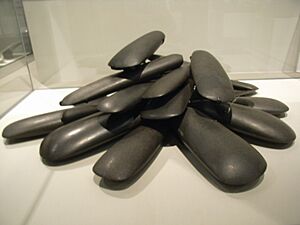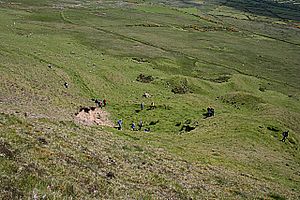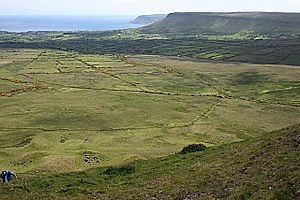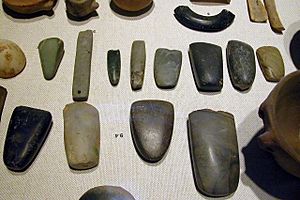Tievebulliagh facts for kids
Quick facts for kids Tievebulliagh (Taobh Builleach) |
|
|---|---|

Tievebulliagh, May 2007. Fragments of porcellanite can be seen among the dolerite in the scree.
|
|
| Highest point | |
| Elevation | 402 m (1,319 ft) |
| Prominence | c. 52 m |
| Listing | Marilyn |
| Geography | |
| Location | County Antrim, Northern Ireland |
| Parent range | Antrim Plateau, Glens of Antrim |
| OSI/OSNI grid | D193268 |
| Topo map | OSNI Discoverer D5 |
Tievebulliagh (which means "Sloping Hill of the Blows" in Irish) is a mountain in Northern Ireland. It stands 402 meters (about 1,319 feet) tall. You can find it in the beautiful Glens of Antrim.
This mountain helps separate the water that flows into the Glenaan valley from the water that flows into the Glenballyemon valley. It's located about 4.4 kilometers (2.7 miles) from a town called Cushendall.
Contents
The Mountain's Geology
Tievebulliagh was formed from an ancient volcanic plug. Imagine a volcano that has gone extinct, and its vent (the opening where lava came out) has hardened into rock. That's a volcanic plug!
The intense heat from the hot, melted rock (called basalt) created a special, super-strong type of rock. This rock is called porcellanite. You can find pieces of this tough, flint-like rock at the bottom of the mountain's eastern slope. You can also see some smaller areas of porcellanite higher up on the mountain's southeast side.
Ancient Discoveries: Archaeology
Scientists have found proof of an ancient axe "factory" at the base of Tievebulliagh. This factory was used by people during the Neolithic period, also known as the New Stone Age. This was a time when people started farming and making polished stone tools.
The axe heads made from Tievebulliagh's unique porcellanite rock were very popular. They have been found all over the British Isles. This includes places as far away as the Outer Hebrides in Scotland and the south coast of England, as well as across the rest of Ireland.
This ancient site is similar to other famous stone tool factories. These include the Langdale axe industry in the Lake District in England and quarries at Penmaenmawr in North Wales. At these places, many stone axes were made.
Workers at Tievebulliagh would "rough out" the axes near the hill and peak. This means they would shape the basic form of the axe. Then, they would take these unfinished axes to the seashore to give them their final smooth finish.
These axes were then traded far and wide! They traveled to places like southwest Ireland, southeast England, and northeast Scotland. Interestingly, no completely finished axes have been found at the Tievebulliagh site itself.
The Malone Hoard
A special collection of 19 polished stone axes was found in Belfast. This collection is known as the "Malone Hoard." These axes were made from the same porcellanite rock found at Tievebulliagh. Some of them were even placed upright in the ground.
These axes might have been too big and heavy for everyday use. This suggests they might have been used for special ceremonies or rituals. Today, you can see the Malone Hoard at the Ulster Museum in Belfast.
Ancient Monuments on the Mountain
On the very top of Tievebulliagh mountain, there is a Bronze Age cairn. A cairn is a mound of stones built by people long ago, often as a burial site or a monument.
Both this round cairn and the Neolithic axe factory at Tievebulliagh are protected as Scheduled Historic Monuments. They are located in the area of Cloghs within the Moyle District Council.
There are many other ancient sites nearby in County Antrim. These include stone circles, long barrows (long burial mounds), and stone rows (lines of standing stones).






